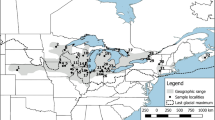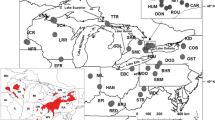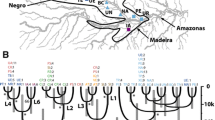Abstract
A previous mtDNA study indicated that female-mediated gene flow was extremely rare among alligator snapping turtle populations in different drainages of the Gulf of Mexico. In this study, we used variation at seven microsatellite DNA loci to assess the possibility of male-mediated gene flow, we augmented the mtDNA survey with additional sampling of the large Mississippi River System, and we evaluated the hypothesis that the consistently low within-population mtDNA diversity reflects past population bottlenecks. The results show that dispersal between drainages of the Gulf of Mexico is rare (F STmsat = 0.43, ΦSTmtDNA = 0.98). Past range-wide bottlenecks are indicated by several genetic signals, including low diversity for microsatellites (1.1–3.9 alleles/locus; H e = 0.06–0.53) and mtDNA (h = 0.00 for most drainages; π = 0.000–0.001). Microsatellite data reinforce the conclusion from mtDNA that the Suwannee River population might eventually be recognized as a distinct taxonomic unit. It was the only population showing fixation or near fixation for otherwise rare microsatellite alleles. Six evolutionarily significant units are recommended on the basis of reciprocal mtDNA monophyly and high levels of microsatellite DNA divergence.



Similar content being viewed by others
References
Avise JC, Bowen BW, Bermingham E, Meylan AB, Lamb T (1992) Mitochondrial DNA evolution at a turtle’s pace: evidence for low genetic variability and reduced microevolutionary rate in the testudines. Mol Biol Evol 9:457–473
Beerli P, Felsenstein J (1999) Maximum-likelihood estimation of migration rates and effective population numbers in two populations using a coalescent approach. Genetics 152:763–773
Beheregaray LB, Ciofi C, Geist D, Gibbs JP, Caccone A, Powell JR (2003) Genes record a prehistoric volcano eruption in the Galapagos. Science 302:75
Bowen BW, Meylan AB, Perran Ross J, Limpus CJ, Balazs GH, Avise JC (1992) Global population structure and natural history of the green turtle (Chelonia mydas) in terms of matriarchal phylogeny. Evolution Int J org Evolution 46:865–881
Bowen BW, Bass AL, Soares L, Toonen RJ (2005) Conservation implications of complex population structure: lessons from the loggerhead turtle (Caretta caretta). Mol Ecol 14:2389–2402
Conant R, Collins JT (1998) A field guide to reptiles and amphibians of eastern and central North America, 3rd edn. Houghton Mifflin, New York
Cornuet JM, Luikart G (1996) Description and power analysis of two tests for detecting recent population bottlenecks from allele frequency data. Genetics 144:2001–2014
Crandall KA, Bininda-Edmonds ORP, Mace GM, Wayne RK (2000) Considering evolutionary process in conservation biology: an alternative to “evolutionary significant units”. Trends Ecol Evol 15:290–295
Di Rienzo A, Peterson AC, Garza JC, Valdes AM, Slatkin M, Freimer NB (1994) Mutational processes of simple-sequence repeat loci in human populations. Proc Natl Acad Sci USA 91:3166–3170
Dobie JL (1971) Reproduction and growth in the alligator snapping turtle, Macroclemys temminckii (Troost). Copeia 1971:645–658
Douglas MR, Brunner PC, McKay LD (2003) Drought in an evolutionary context: molecular variability in Flannelmouth Sucker (Catostomus latipinnis) from the Colorado River Basin of western North America. Freshwater Biol 48:1254–1273
Driese SG, Zheng-Hua L, McKay LD (2008) Evidence for multiple, episodic, mid-Holocene Hypsithermal recorded in two soil profiles along an alluvial floodplain catena, southeastern Tennessee, USA. Quaternary Res 69:276–291
Ernst CH, Lovich JE, Barbour RW (1994) Turtles of the United States and Canada. Smithsonian Institution Press, Washington, DC
Excoffier L, Laval G, Schneider S (2005) Arlequin ver. 3.0: an integrated software package for population genetics data analysis. Evol Bioinformatics Online 1:47–50
Fitzsimmons NN (1998) Single paternity of clutches and sperm storage in the promiscuous green turtle (Chelonia mydas). Mol Ecol 7:575–584
Fitzsimmons NN, Hart KM (2007) Genetic studies of freshwater turtles and tortoises: a review of the past 70 years. In: Shaffer HB, FitzSimmons NN, Georges A, Rhodin AGJ (eds) Defining turtle diversity: proceedings of a workshop on genetics, ethics, and taxonomy of freshwater turtles and tortoises. Chelonian Research Monographs 4:15–46
Fitzsimmons NN, Moritz C, Limpus CJ, Pope L, Prince R (1997) Geographic structure of mitochondrial and nuclear gene polymorphisms in Australian green turtle populations and male-biased gene flow. Genetics 147:1843–1854
Garza JC, Williamson EG (2001) Detection of reduction in population size using data from microsatellite loci. Mol Ecol 10:305–318
Goudet J (1995) FSTAT (Version 1.2): a computer program to calculate F-statistics. J Hered 86:485–486
Grant WS, Bowen BW (1998) Shallow population histories in deep evolutionary lineages of marine fishes: insights from sardines and anchovies and lessons for conservation. J Hered 89:415–426
Hackler JC, Van Den Bussche RA, Leslie DM Jr (2007) Characterization of microsatellite DNA markers for the alligator snapping turtle, Macrochelys temminckii. Mol Ecol Notes 7:474–476
Hardy OJ, Vekemans X (2002) SPAGeDi: a versatile computer program to analyse spatial genetic structure at the individual or population levels. Mol Ecol Notes 2:618–620
Hauswaldt JS, Glenn TC (2005) Population genetics of the diamondback terrapin (Malaclemys terrapin). Mol Ecol 14:723–732
Hedrick PW (1999) Perspective: highly variable loci and their interpretation in evolution and conservation. Evolution 53:313–318
Hedrick PW (2000) Genetics of populations. Jones and Bartlett, Sudbury
Hedrick PW (2005) A standardized genetic differentiation measure. Evolution 59:1633–1638
IUCN (2008) The 2008 IUCN red list of threatened species. http://www.redlist.org. Accessed 7 Jan 2009
Kuo C-H, Janzen FJ (2003) BOTTLESIM: a bottleneck simulation program for long-lived species with overlapping generations. Mol Ecol Notes 3:669–673
Kuo C-H, Janzen FJ (2004) Genetic effects of a persistent bottleneck on a natural population of ornate box turtles (Terrapene ornata). Conserv Gen 5:425–437
Longmire JL, Maltbie M, Baker RJ (1997) Use of lysis buffer in DNA isolation and its implications for museum collections. Occ Pap, Mus, Texas Tech Univ 163:1–3
Luikart G, Allendorf FW, Cornuet J-M, Sherwin WB (1998) Distortion of allele frequency distributions provides a test for recent population bottlenecks. J Hered 89:238–247
McGaugh SE, Eckerman CM, Janzen FJ (2008) Molecular phylogeography of Apalone spinifera (Reptilia, Trionychidae). Zoologica Scripta 37:289–304
Meirmans PG (2006) Using the AMOVA framework to estimate a standardized genetic differentiation measure. Evolution 60:2399–2402
Mills LS, Allendorf FW (1996) The one-migrant-per-generation rule in conservation and management. Conserv Biol 10:1509–1518
Moritz CC (1994) Defining “evolutionary significant units” for conservation. Trends Ecol Evol 9:373–375
Oxford Molecular Group PLC (1998) AssemblyLIGNTM, Version 1.0.9. Oxford Molecular Group PLC, Oxford
Oyler-McCance SJ, Ransler FA, Berkman LK, Quinn TW (2007) A rangewide population genetic study of trumpeter swans. Conserv Gen 8:1339–1353
Peakall R, Smouse PE (2006) Genalex 6: genetic analysis in Excel. Population genetic software for teaching and research. Mol Ecol Notes 6:288–295
Phillips CA, Suau G, Templeton AR (2000) Effects of Holocene climatic fluctuation on mitochondrial DNA variation in the ringed salamander, Ambystoma annulatum. Copeia 2000:542–545
Piry S, Alapetite A, Cornuet J-M, Paetkau D, Baudouin L, Estoup A (2004) GeneClass2: a software for genetic assignment and first-generation migrant detection. J Hered 95:536–539
Pritchard PCH (1989) The alligator snapping turtle: biology and conservation. Milwaukee Public Museum, Milwaukee
Pritchard PCH (2006) The alligator snapping turtle: biology and conservation. Krieger Publishing, Malabar updated edition
Pritchard JK, Stephens M, Donnelly P (2000) Inference of population structure using multilocus genotype data. Genetics 155:945–959
Rannala B, Mountain JL (1997) Detecting immigration by using multilocus genotypes. Proc Natl Acad Sci USA 94:9197–9221
Raymond M, Roussett F (1995) FSTAT version 1.2: a population genetics software for exact test of population differentiation. Evolution 49:1280–1283
Rice WR (1989) Analyzing tables of statistical tests. Evolution 43:223–225
Riedle JD, Shipman PA, Fox SF, Leslie DM Jr (2005) Status and distribution of the alligator snapping turtle, Macrochelys temminckii, in Oklahoma. Southwest Nat 50:79–84
Riedle JD, Shipman PA, Fox SF, Hackler JC, Leslie DM Jr (2008) Structure of the AlligatorSnapping Turtle, Macrochelys temminckii, on the western edge of its distribution. Chelonian Conserv Biol 7:100–104
Roberts MA, Schwartz TS, Karl SA (2004) Global population genetic structure and male-mediated gene flow in the green sea turtle (Chelonia mydas): analysis of microsatellite loci. Genetics 166:1857–1870
Roman J, Santhuff SD, Moler PE, Bowen BW (1999) Population structure and cryptic evolutionary units in the alligator snapping turtle. Conserv Biol 13:135–142
Rosenbaum PA, Robertson JM, Zamudio KR (2007) Unexpectedly low genetic divergences among populations of the threatened bog turtle (Glyptemys muhlenbergii). Conserv Gen 8:331–342
Shipman PA (1993) Alligator snapping turtle, habitat selection, movements, and natural history in southeast Kansas. Thesis, Emporia State University, Emporia, Kansas
Sloan KN, Lovich JE (1995) Exploitation of the alligator snapping turtle, Macroclemys temminckii, in Louisiana: a case study. Chelonian Conserv Biol 1:221–222
Smouse PE, Peakall R (1999) Spatial autocorrelation analysis of individual multiallele and multilocus genetic structure. Mol Ecol 82:561–573
Spear SF, Peterson CR, Matocq MD, Storfer A (2006) Molecular evidence for historical and recent population size reductions of tiger salamanders (Ambystoma tigrinum) in Yellowstone National Park. Conserv Gen 7:605–611
Tallmon DA, Koyuk A, Luikart GH, Beaumont MA (2008) ONeSAMP: a program to estimate effective population size using approximate Bayesian computation. Mol Ecol Res 8:299–301
Thompson JD, Gibson TJ, Plewniak F, Jeanmougin F, Higgins DG (1997) The CLUSTAL X windows interface: flexible strategies for multiple sequence alignment aided by quality analysis tools. Nuc Acids Res 25:4876–4882
USFWS (2005) Inclusion of alligator snapping turtle (Macroclemys [=Macrochelys] temminckii) and all species of map turtle (Graptemys spp.) in Appendix III to the convention on international trade in endangered species of wild fauna and flora. US Federal Register 70:74700–74712
Van Oosterhout CW, Hutchinson FD, Wills PM, Shipley P (2004) Micro-Checker: software for identifying and correcting genotyping errors in microsatellite data. Mol Ecol Notes 4:535–538
Walker D, Moler PE, Buhlmann KA, Avise JC (1998) Phylogeographic uniformity in mitochondrial DNA of the snapping turtle (Chelydra serpentina). Anim Cons 1:55–60
Waples RS (1991) Pacific Salmon, Oncorhynychus spp., and the definition of a species under the Endangered Species Act. Marine Fish Rev 53:11–22
Waples RS, Do C (2008) LDNE: a program for estimating effective population size from data on linkage disequilibrium. Mol Ecol Resour 8:753–756
Acknowledgments
We thank B. W. Bowen for valuable comments on an early draft of the manuscript, M. Crepeau for preparing and shipping DNA aliquots, N. Lang for laboratory assistance, F. Janzen for helpful advice, C.-H. Kuo for providing his data on ornate box turtle, and personnel of the Sequoyah, Tishomingo, and Little River national wildlife refuges for their cooperation. We extend deep gratitude to the many individuals that helped with collecting alligator snapping turtles or gaining access to museum specimens, most recently, S. Baker, R. Brandon, M. Dreslik, R. Gillespie, J. Hartleb, S. Krueger, D. Ligon, J. MacGregor, M. Mahoney, D. Moore, A. Resetar, L. Rodman, A. Scott, L. Willis, and E. Zimmerer. Financial support provided by State Wildlife Grants under Project T-5-P of the Oklahoma Department of Wildlife Conservation and administered through the Oklahoma Cooperative Fish and Wildlife Research Unit (cooperators are Oklahoma State University, Oklahoma Department of Wildlife Conservation, United States Geological Survey, United States Fish and Wildlife Service, and Wildlife Management Institute). Financial support was also provided by the US Fish and Wildlife Service, the Division of Natural Heritage of the Illinois Department of Natural Resources and the Department of Zoology, Oklahoma State University. The use of trade, product, industry or firm names or products or software or models, whether commercially available or not, does not constitute endorsement by the US Government or the US Geological Survey.
Author information
Authors and Affiliations
Corresponding author
Appendix 1
Appendix 1
Specimens assayed. Locality number and drainage name in bold (Fig. 1). Number of turtles assayed in parentheses (mtDNA/microsatellites). Museum sources are listed under the following acronyms: FMNH = Field Museum of Natural History, Chicago, ISM = Illinois State Museum, Springfield, UIMNH = University of Illinois Museum of Natural History, APU = Austin Peay State University, Tennessee.
1 Trinity River (3/3); Bedias Creek, Madison and Leon Counties, Texas (3/3). 2 Neches River (18/11); Bingham Lake, Tyler County, Texas (18/11). 3A Middle Mississippi River (13/13); Wolf Bayou Conservation Area, Pemiscott County, Missouri (7/7), FMNH 3234, Ohio River at Cairo, Alexander County, Illinois (1/1), UIMNH 33124, Mississippi River at Chester, Randolph County, Illinois (1/1), Wolf Creek, Jackson County, Illinois (1/1), ISM 689915, Dutch Creek, Union County, Illinois (1/1), APU #0-10,11, Kentucky Lake at Whiteoak Creek, Houston County, Tennessee (1/1), APU #1-3, Kentucky Lake at Tischel Bay, Stewart County, Tennessee (1/1). 3B White River (12/12); Black River, Butler County, Missouri (11/11), Cache River, unknown county, Arkansas (1/1). 3C Arkansas River (33/33); Little Vian Creek, Sequoyah County, Oklahoma (8/8), Big Vian Creek, Sequoyah County, Oklahoma (8/8), Hezekiah Creek, Sequoyah County, Oklahoma (4/4), Dirty Creek, Muskogee County, Oklahoma (12/12), Briar Creek, Haskell County, Oklahoma (1/1). 3D Canadian River (10/10); Mill Creek, McIntosh County, Oklahoma (10). 3E Little and Kiamichi rivers (6/6); Hugo Lake, Choctaw County, Oklahoma (1/1), Mill Creek, Pushmataha County, Oklahoma (1/1), Mud Creek, McCurtain County, Oklahoma (1/1) Forked Lake, McCurtain County, Oklahoma (3/3). 3F Lower Red River (4/4); Coushatta Bayou, Red River Parish, Louisiana (4/4), 3G Lower Mississippi River (13/6); Tensas River, Madison Parish, Louisiana (1/1), Bayou Gallion, Morehouse Parish, Louisiana (3/2,) Bayou Desiard, Ouachita Parish, Louisiana (5/2), Bayou D’Arbonne, Union Parish, Louisiana (1/1). 4 Pascagoula River (13/13); Pascagoula River, Jackson County, Mississippi (13/3). 5 Mobile Bay (12); Bear Creek, Baldwin County, Alabama (3/3), Southern Delta, Balwin County, Alabama, (2/2) Turkey Creek, Baldwin County, Alabama (5/5), Tallapoosa River, Macon County, Alabama (1/1), Lost Creek, Walker County, Alabama (1/1). 6 Perdido Bay (1/1); Styx River, Baldwin County, Alabama (1/1). 7 Pensacola Bay (23/20); Conecuh River, Covington-Crenshaw counties, Alabama (4/4), Escambia River, Escambia County, Alabama (5/4), Escambia River, Santa Rosa County, Florida (1/1), East Bay River, Okaloosa County, Florida (4/3), Shoal River, Okaloosa County, Florida (3/3), Yellow River, Okaloosa County, Florida (4/3), Blackwater River, Santa Rosa County, Florida (2/2). 8 Choctawhatchee River (2/2); Holmes Creek, Washington County, Florida (2/2). 9 Econfina River (8/2); Blue Springs, Washington County, Florida (8/2). 10 Apalachicola River (25/23); Apalachicola River, Calhoun County, Florida (1/1), The Bayou, Calhoun County, Florida (15/15), Chipola River, Jackson County, Florida (9/7). 11 Ochlockonee River (10/10); Ochlockonee River, Liberty County, Florida (5/5), Ochlockonee River, Leon County, Florida (2/2), Ochlockonee River, Wakulla County, Florida (3/3). 12 Suwannee River (18/15); Withlacoochie River, Lowndes County, Georgia (1/0), Alapaha River, Lowndes County, Georgia (1/0), Santa Fe River, Alachua and Union counties, Florida (10/9), New River, Union County, Florida (1/1), Suwannee River, Dixie County, Florida (3/3), Suwannee River, Suwannee County, Florida (2/2).
Rights and permissions
About this article
Cite this article
Echelle, A.A., Hackler, J.C., Lack, J.B. et al. Conservation genetics of the alligator snapping turtle: cytonuclear evidence of range-wide bottleneck effects and unusually pronounced geographic structure. Conserv Genet 11, 1375–1387 (2010). https://doi.org/10.1007/s10592-009-9966-1
Received:
Accepted:
Published:
Issue Date:
DOI: https://doi.org/10.1007/s10592-009-9966-1




